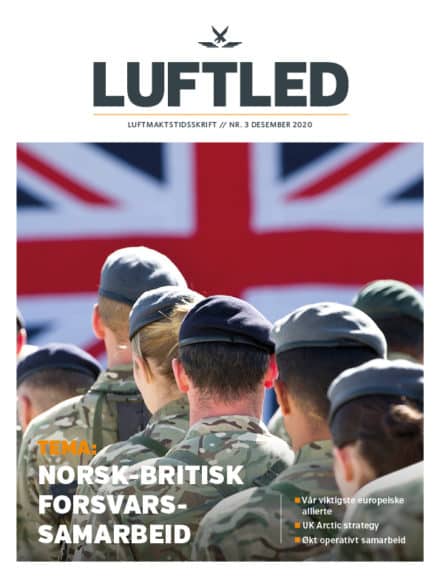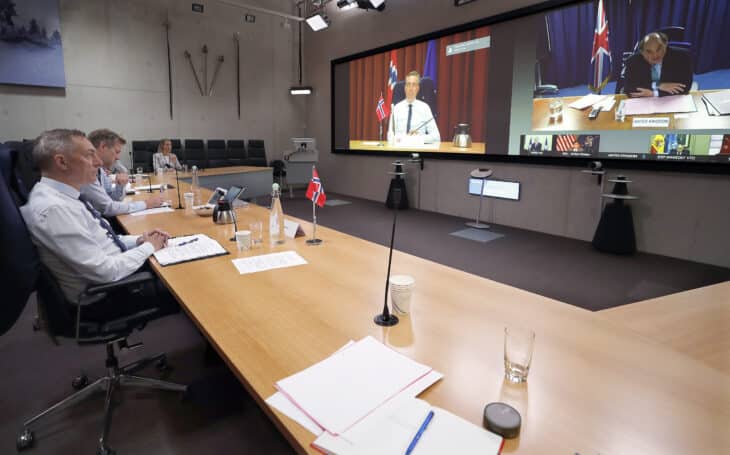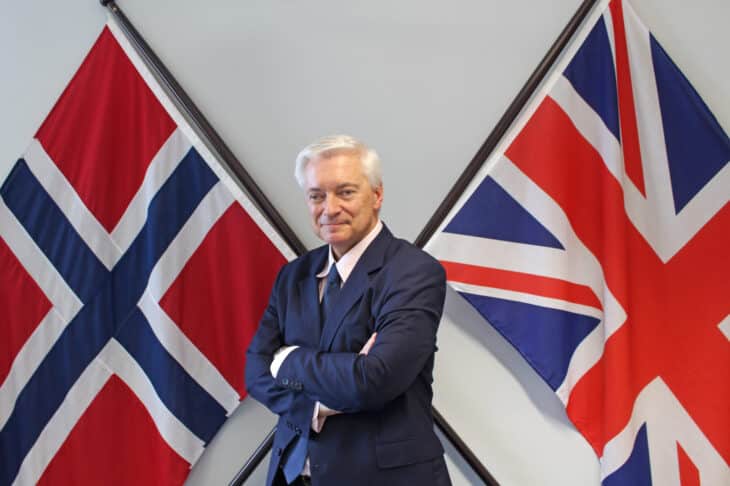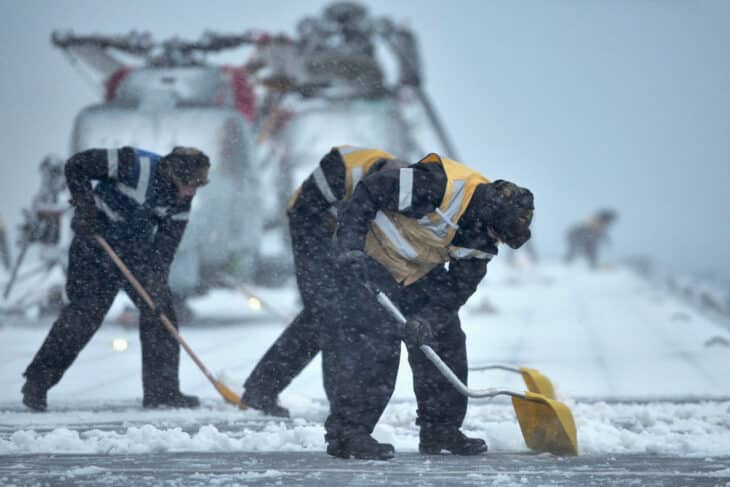THE ROYAL MARINES IN NORWAY: Project Heimdall
The Royal Marines have a strong connection with Arctic warfare in Norway. It started with No. 14 (Arctic) Commando, formed in late 1942, for action against the German Kriegsmarine and Luftwaffe bases in Norway being used to attack allied Arctic Convoys.

There was sporadic interaction after the Second World War, but 41 Commando’s deployment in 1963 heralded the start of a new era. Since then, the Royal Marines have deployed to Norway every year and have remained the UK’s military experts in “Mountain and Cold Weather Warfare”. During the Cold War period this deployment bolstered/reinforced in-place Norwegian forces to protect NATO’s exposed Northern flank. 3 Commando Brigade, charged with the maintenance of the capability, would often deploy at scale and with everything it needed for a 3-4-month period. These annual deployments continued following the collapse of the Soviet Union, but over time, became less about conventional deterrence and more about environmental training. By the 2010 Strategic Defence and Security Review (SDSR), with resource constraints biting and the focus of 3 Commando Brigade’s outputs shifting to other operational tasking, a decision was made to reduce the scale of aspiration from regular Brigade-sized deployments to a ‘more affordable’ Company level. Operational priorities consumed the Corps’ focus but retaining a meaningful artic warfare capability remained a RM goal. At the 2015 SDSR, with a revanchist Russia challenging the liberal world order, there was a renewed focus on the High North and the UK’s role in Norway. More resource was allocated and there was a political and military desire to ‘do more’. Training was elevated to the Commando (Battalion) and its 1* Headquarters and by 2018 thinking began to crystallise around developing a better way of planning and exploiting the opportunities to work and train in the High North with one of our closest Allies. That thinking resulted in the idea of a coherent strategy with a 10-year horizon, that, at its very heart, not only forecasts the numbers and capabilities that will deploy to Norway over time, but also incorporate the new ‘Future Commando Force’ into the exercise design. This 10-year plan is Project HEIMDALL.
This article seeks to inform the readership on Project HEIMDALL. It will explain why we are doing it from the strategic, operational and tactical levels; what we are doing now; and, what we could do in the future.
WHY PROJECT HEIMDALL?
At the strategic level, Europe faces a new and daunting security environment and the UK has made it clear that it will reassure her allies as well as secure her energy sources. At the operational level there is a desire to bring operational coherence and credibility. At the tactical level, there is need for rejuvenated co-operation and integration.
Strategically, for two decades the Russian National Security Concept has been arguably more vigorous in preparing for a proximal challenge, with clear intent to pursue a vigorous foreign policy with ‘political, economic and other measures’.1 General Valery Gerasimov, Chief of the General Staff of the Armed Forces of the Russian Federation, has pointed out that Russia’s doctrine emphasises the utility of non-military means between peace and war, which has been demonstrated several times in its ‘near abroad’.2 The last few years have seen new Russian Arctic capabilities being fielded, new operating concepts and doctrine for Hybrid Maritime Warfare, and a new Arctic Joint Strike Command for maritime forces.3 In addition, the opening of sea routes through the Arctic means global trade and interested parties are coming: since 2015 China has overturned its previous reluctance to embark on hegemonic or neo-imperialist polices of base-building overseas.4 According to the UK’s First Sea Lord, Admiral Tony Radakin, ‘the areas of competition continue to shift northwards’.5 As a result, the UK has made clear and unequivocal statements that operating in Norway and the Arctic region remains a key output of UK Defence strategy and therefore within the Royal Navy and 3 Commando Brigade Royal Marines.
At the operational level, it should be remembered that the UK’s contribution is greater than just 3 Commando Brigade. Many UK Force Elements conduct training and exercises in Norway and/or with Norwegians in the UK; from combined F35 operations through to the provision of P8s to cadets. The Royal Norwegian Navy certifies its frigates at Devonport and our two Navies operate together in the North Atlantic on a regular basis. The Royal Marines’ ‘Future Commando Force’ will consist of two Littoral Response Groups each of around 500 commandos and additional supporting troops ‘permanently deployed, ready to deliver effects…’6, one of which will be earmarked for activity in and around the High North in support of NATO.
At the tactical level, there is a recognition that the Royal Marines need to change the way they operate in Norway. In 2015 the then Brigade Commander wrote a think piece on how they would fight in the future ‘…to shape our thinking and training/force design as we progressively develop…’.7 The note took the totality of the Mountain and Cold Weather Warfare capability into view. It included support helicopters, the Royal Dutch Marine Corps and a balanced approach to deploying technical and mobility capabilities. It sought to operationalise all deployed activity. Unfortunately implementation was delayed due to ‘lean’ training years in 2016-2018, but, a new Arctic strategy announced in 2018 by the Secretary of Defence heralded a renewed opportunity;8 the idea of the ’10 year plan’ was born. Project HEIMDALL is routinely based on Commando level deployments. The Project has two developmental lines; during odd years (Exercise Aquila) the focus is on training the ‘enablers’ and the even years (Exercise Cetus) trains the fighting echelons and will include participation on Exercise Cold Response. 3 Commando Brigade harbours the aspiration to conduct a full Brigade deployment to Norway in 2028.
Project HEIMDALL encompasses the strategic, operational and tactical levels. It ensures the linkages between ends, ways and means for the Royal Marines in the High North.
The UK has made clear and unequivocal statements that operating in Norway and the Arctic region remains a key output of UK Defence strategy
ROJECT HEIMDALL NOW
As a result of this new and clearly articulated direction, Royal Marines’ ambition in Norway increased from the Company level nadir of 2016-2018 back to Commando (Battalion) level with a 3 Commando Brigade Headquarters ‘wrap’ for Winter Deployment 2020, but now with a new mantra: ‘training with the Norwegians and other allies in Norway’ rather than merely ‘training in Norway’. To reinforce this intent, Commander 3 Commando Brigade relocated his Royal Marines Headquarters elements from Åsegarden (its traditional site) to Bardufoss in 2018, in a jointly agreed decision with the Commander of Brigade North. We now aspire to achieve the same levels of integration between the Norwegian Army and the Royal Marines of 3 Commando Brigade that the Commando Helicopter Force enjoys with the Royal Norwegian Air Force (Exercise Clockwork). Future training would also be delivered as realistically as possible, ‘to operationalise the training’.
As a result of the new training mantra and joint training methodologies, Exercise Cold Response 2020 was the first big test and a resounding success. 3 Commando Brigade HQ acted as the CLF (Commander Land Forces) and the Dutch Navy’s Maritime Forces Headquarters (HQ NLMARFOR) acted as the CATF (Commander Amphibious Task Force). CATF had a number of NATO warships under command, and CLF had 45 Commando Royal Marines, 2 Battalion Royal Netherlands Marine Corps, elements of 24 Commando Royal Engineers, 29 Commando Royal Artillery, 30 Commando Information Exploitation Group Royal Marines, and the Commando Logistic Regiment under command. Collectively, the group successfully worked as a prototype ‘Future Commando Force’ with the landing force operating in multiple smaller and more dispersed groupings. Throughout the Exercise, every opportunity was taken to conduct considerable experimentation to test some emerging above-, on- and under-water technologies. The opportunity to meet up and fight alongside Brigade North was stymied due to the COVID-19 pandemic, but the planning undertaken and momentum gained will be built upon for the Winter Deployment 2021 and subsequent years. The ultimate goal is for future exercise design to accommodate and test the Future Commando Force operating model, fully integrating with allied partners.
PROJECT HEIMDALL IN THE FUTURE
There is a fundamental requirement to ensure the Future Commando Force is better integrated with allies on doctrine and tactics to ensure optimum training is achieved in preparation for future tasks. Interoperability is not only about technology and hardware, but also about mind-sets and ideas. There needs to be a renewed focus on other domains, especially cyber, to deliver greater effect. Whilst there is a call for integration and interoperability with allies it is not always clear how this can practically be achieved. At certain levels interoperability and an ability to be interchangeable is evident, but the enduring reality of individually equipped nations hampers true interchangeability due to equipment and communication differences.
In 2016, NATO established enhanced forward presence battlegroups in the Baltic States. Considered by some as offering minimal contribution to deterrence, they remain a clear demonstration of commitment to defend the region.9 Although the UK is not seeking to permanently base advanced force elements in Norway, there are other opportunities to increase forward presence. The First Sea Lord wants value for money at the operational level, and has noted that ‘there is a shift within Defence [thinking]…towards forces that are deployed forward and in constant use, delivering value for money’.10 This is fully in line with the Chief of Defence’s newly published Integrated Operating Concept. This direction presents 3 Commando Brigade with an opportunity to ‘operationalise’ the deployment, sustainment and recovery of forces to Norway. Limiting the circle of knowledge to those responsible for booking strategic shipping and air transport, the actual processing of personnel and kit could then be achieved in 5 days rather than a weeks/months, supported by a ‘Norwegian’ home team conducting “in-theatre” Reception, Staging and Onward Integration (RSOI). Thereafter the deployment forward could be enabled by a combination of road moves (as the British Army did for a Battle Group to join Trident Juncture in 2018), and para/air drops (as 3 Commando Brigade’s Surveillance and Reconnaissance Squadron practised on Exercise Northern Winds in 2019 and again on Exercise Cold Response 2020).
There is an urgent need to provide doctrinally sound and sufficiently administered exercises and training to support complete Littoral Response Groups (LRGs) and their supporting UK Joint assets on these demanding exercises without the distraction of their own real-life support. Mountain and Cold Weather Warfare needs to be made relevant to the Integrated Operating Concept; it must be developed into a relevant concept that is fully integrated into the five Domains, especially cyber (which could be delivered by 30 Commando Information Exploitation Group Royal Marines). Consideration should be given to pre-positioning stock and equipment to reduce deployment timescales and lift requirements. If this is seen as ‘progress’ then it must be considered, but it cannot come at the expense of the current UK-based workforce; a tracked vehicle fleet (BV and over snow reconnaissance vehicles) maintained by Norwegian contractors in Norway could make sense.
Significant collective Arctic warfare expertise has been lost over time due to prioritised operational deployments. 20 years ago, Companies would be filled with marines who had completed multiple deployments to Norway. Today, most Companies have few marines who have completed one, let alone two deployments. Collective experience is not what it used to be but will improve if the advantages implicit within Project HEIMDALL are harvested. A review of the deployment pipeline could present quick wins: pre-deployment mountain-training could become more pre-Arctic training based; cold weather warfare courses could be updated to ensure a greater degree of class participation and deliver higher levels of cognitive appreciation of what is being taught theoretically into practical experience but also reputational point of view11; joint staff rides and wargames could be conducted; exercises could be based on Norway’s defence plans; and, Norwegians could be used to train 3 Commando Brigade personnel. Finally, and in order to boost Royal Marines/Brigade and Norway/Brigade North cooperation, short- and/or long-term exchanges of key personnel could take place to aid continuity.
The recent arrival of a Royal Marine Warrant Officer Mountain Leader to the Norwegian Army Winter Warfare School is a good start.
In summary, the more that can be done to operationalise training, the better. The Royal Marines and Norwegian Army must exercise together using updated national contingency plans, and where possible, include the Dutch RNLMC and American USMC partners. This would facilitate realistic training, exercises and operations.
The recent arrival of a Royal Marine Warrant Officer Mountain Leader to the Norwegian Army Winter Warfare School is a good start





